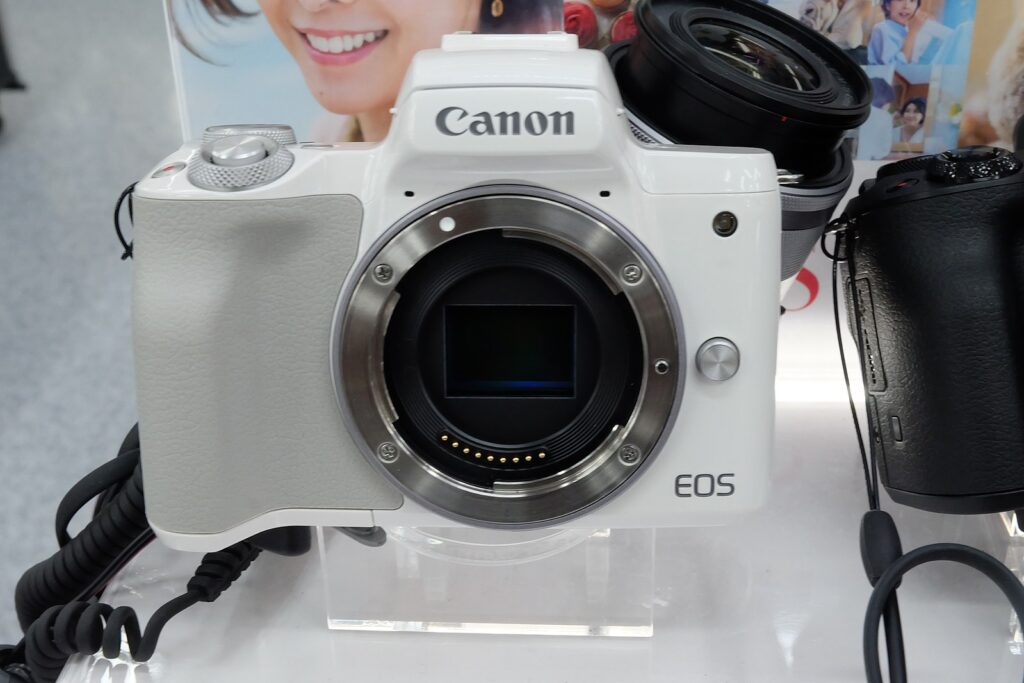
Seven years after its debut, the Canon EOS M50 remains a nostalgic favorite among photography enthusiasts—a testament to its role in popularizing accessible mirrorless hybrid shooting.
Once praised for its balance of portability and performance, this APS-C camera now shows its age in an era dominated by Canon’s RF-mount systems like the EOS R50. Let’s revisit the M50’s legacy, its limitations in 2025, and whether it still deserves a spot in your gear bag.
The Original Appeal of the Canon EOS M50
Launched in 2018, the EOS M50 carved a niche with features that catered to vloggers, travel photographers, and hobbyists:
- Compact, Lightweight Design: Weighing just 387g, it was ideal for on-the-go creators.
- Fully Articulating Touchscreen: A 3.0-inch flip-out LCD enabled easy self-recording and creative angles.
- Dual Pixel CMOS AF: Reliable autofocus (AF) with eye detection kept subjects sharp, even for beginners.
- 4K Video Capability: At launch, its 4K/24p recording (albeit with a heavy crop) felt forward-thinking.
These traits made the M50 a gateway into mirrorless cameras, especially for those transitioning from smartphones or DSLRs.
Limitations in 2025: Why the EOS M50 Feels Outdated
While the M50 still handles basic photography well, modern content creators face glaring compromises:
- Severely Cropped 4K Video: The M50’s 4K mode uses a 1.6x crop (beyond its APS-C sensor), making wide-angle shots impractical. In 2025, uncropped 4K is standard even in entry-level models.
- Limited EF-M Lens Ecosystem: Canon’s shift to RF lenses left the EF-M mount underdeveloped. Only 10 native lenses exist, with no new releases since 2022.
- No In-Body Image Stabilization (IBIS): Reliance on lens-based stabilization limits handheld video and low-light flexibility.
- Outdated Connectivity: Bluetooth and Wi-Fi transfer speeds feel sluggish compared to newer cameras with cloud sync and enhanced smartphone integration.
These shortcomings are magnified next to Canon’s own EOS R50, which addresses nearly every flaw.
Canon EOS M50 vs. R50: A New Era of Hybrid Shooting
The 2023-launched EOS R50 represents Canon’s RF-mount evolution, offering critical upgrades over the M50:
- Uncropped 4K/30p Video: The R50’s 4K footage uses the full sensor width, paired with 6K oversampling for sharper detail.
- Expansive RF Lens Library: Access to 40+ RF lenses (including affordable APS-C options) future-proofs investments.
- Advanced AF & IBIS: The R50 adds subject-tracking AF for vehicles and animals, while IBIS compensates for shaky hands.
- Faster Workflows: Cloud connectivity, vertical video support, and improved livestreaming tools cater to modern creators.
Though the R50 is slightly bulkier, its refinements justify the size difference.
Who Should Still Buy the Canon EOS M50 in 2025?
The M50 isn’t obsolete—yet. It’s worth considering for:
- Budget-Consistent Beginners: Used M50 bodies sell for under $400, a steal for learning photography basics.
- EF-M Lens Owners: Existing users can expand their kit with discounted EF-M lenses (e.g., the EF-M 32mm f/1.4).
- Secondary/Backup Cameras: Its portability shines for travel vlogging or as a lightweight B-cam.
- 1080p-First Creators: If 4K isn’t a priority, its HD video and DPAF still hold up for casual use.
If you’re shopping for a hybrid mirrorless camera in 2025, you have two solid paths:
- Buy a Used Canon EOS M50 at KEH – Great for beginners and budget shooters.
- Shop the Canon EOS R50 on Amazon – A modern, future-proof upgrade with RF lens support.
Final Verdict
The Canon EOS M50 remains a functional tool for hobbyists, but its age is undeniable. While the EOS R50 and RF system define Canon’s future, the M50’s affordability and simplicity keep it relevant in niche scenarios. For most, however, investing in the R50 ensures better longevity, performance, and creative freedom in 2025’s competitive hybrid-shooting landscape.
Frequently Asked Questions
Is the Canon EOS M50 good for beginners?
Yes, the M50 remains a great entry point for new photographers with intuitive controls and solid image quality in 1080p.
Does the M50 record in 4K?
Yes, but 4K video is heavily cropped and lacks Dual Pixel autofocus, making it less ideal for serious creators.
What lenses are compatible with the Canon M50?
The M50 uses Canon’s EF-M mount. You can also adapt EF and EF-S lenses with an optional mount adapter.
Can I still buy the Canon M50 new?
It’s still available at some retailers, but most units sold in 2025 are used or refurbished.
Is the R50 a direct upgrade to the M50?
Yes. The Canon EOS R50 offers full-sensor 4K, RF mount compatibility, and better video and autofocus performance, making it a natural upgrade.
People Also Ask
Is the Canon EOS M50 still good in 2025?
Yes, it’s still good for beginners and casual photographers, especially for 1080p video and basic photography. But it’s limited compared to newer RF-mount options.
What is the difference between Canon M50 and R50?
The R50 features uncropped 4K, advanced autofocus, access to RF lenses, and better connectivity. The M50 has a cropped 4K mode and limited lens options.
Does the Canon M50 have image stabilization?
No, the M50 does not have in-body image stabilization (IBIS). Stabilization is lens-dependent.
Can the Canon M50 livestream?
Yes, but it requires third-party software or USB workarounds. Newer cameras like the R50 have better native streaming tools.
Is the Canon EOS M system discontinued?
Canon hasn’t officially discontinued EF-M, but no new lenses have been released since 2022, and all new development is focused on RF.
